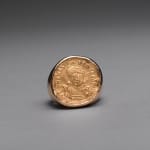Gold Ring Featuring a Byzantine Gold Coin of Emperor Anastasius I, 491 CE - 518 CE
Gold
FJ.6772
Further images
This genuine Ancient Byzantine gold coin has been mounted in a modern 18 Karat gold rin Anastasius was born in Dyrrachium (modern Durazzo, in Albania), on the Adriatic coast, around...
This genuine Ancient Byzantine gold coin has been mounted in a modern 18 Karat gold rin
Anastasius was born in Dyrrachium (modern Durazzo, in Albania), on the Adriatic coast, around 430 A.D. He was not prominent at the court of Zeno, reaching the minor rank of silentiary in the palace. His religious knowledge, however, meant he was considered in 488 for promotion to bishop of Antioch. After Zeno's death, Anastasius was declared emperor April 11, 491. Anastasius was the choice of Ariadne, Zeno's widow, and seems to have been a surprise to the aristocracy. A month after his accession, on May 20, 491, Anastasius married Ariadne but the marriage produced no children. He was buried with Ariadne in the Church of the Holy Apostles in Constantinople. Anastasius was nicknamed "Dicorus" (Two-Pupils), because of his multi-colored eyes (one black, one blue). He died July 8 or 10, 518 and was succeeded by Justin I.
This stunning ring evokes the glory and beauty of the early Christian era and its flowering. The gold of the ring and the gold of the coin both complement each other. Together, the two hues merge into a lustrous splendor of precious metal. This coin is a fitting memorial of Anastasius, the man responsible for perfecting the Empire’s monetary system and increasing its treasury. There is an eternal splendor to this ring, a beauty that radiates from within the coin and envelopes the gold setting. To wear this ring is to evoke the spirit of change. For although time changes and the world evolves, true beauty and elegance as defined by this ring are eternal and immune to the fancies and whims of individual tastes.
Anastasius was born in Dyrrachium (modern Durazzo, in Albania), on the Adriatic coast, around 430 A.D. He was not prominent at the court of Zeno, reaching the minor rank of silentiary in the palace. His religious knowledge, however, meant he was considered in 488 for promotion to bishop of Antioch. After Zeno's death, Anastasius was declared emperor April 11, 491. Anastasius was the choice of Ariadne, Zeno's widow, and seems to have been a surprise to the aristocracy. A month after his accession, on May 20, 491, Anastasius married Ariadne but the marriage produced no children. He was buried with Ariadne in the Church of the Holy Apostles in Constantinople. Anastasius was nicknamed "Dicorus" (Two-Pupils), because of his multi-colored eyes (one black, one blue). He died July 8 or 10, 518 and was succeeded by Justin I.
This stunning ring evokes the glory and beauty of the early Christian era and its flowering. The gold of the ring and the gold of the coin both complement each other. Together, the two hues merge into a lustrous splendor of precious metal. This coin is a fitting memorial of Anastasius, the man responsible for perfecting the Empire’s monetary system and increasing its treasury. There is an eternal splendor to this ring, a beauty that radiates from within the coin and envelopes the gold setting. To wear this ring is to evoke the spirit of change. For although time changes and the world evolves, true beauty and elegance as defined by this ring are eternal and immune to the fancies and whims of individual tastes.





